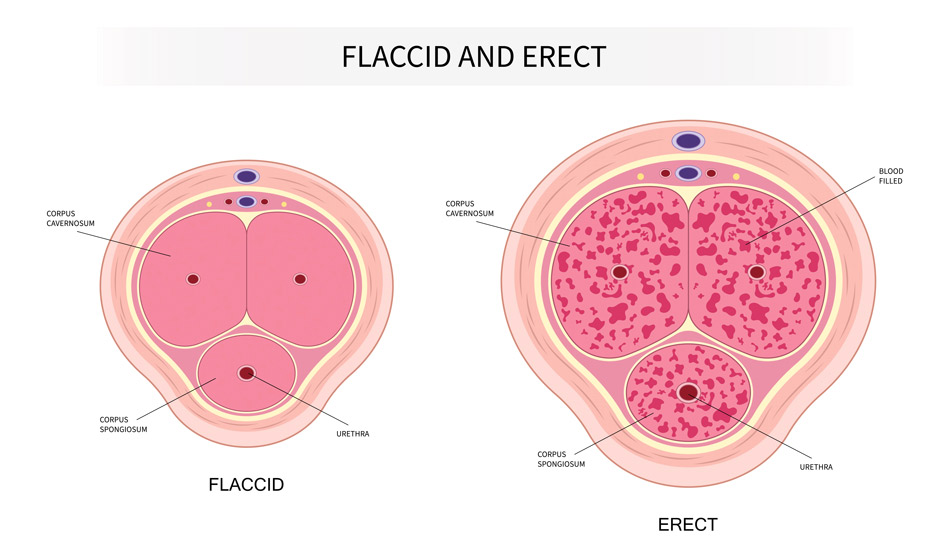
A recent randomized controlled trial (RCT) conducted at Xiyuan Hospital, China Academy of Chinese Medical Sciences, demonstrated significant benefits of acupuncture for psychogenic erectile dysfunction (pED). Researchers found that acupuncture treatments led to notable improvements in erectile function and psychological symptoms compared to sham acupuncture treatments [1].
The RCT involved 66 male participants, aged 20–50, who were diagnosed with pED. These participants were randomly assigned to either the acupuncture group (n = 33) or the sham acupuncture group (n = 33). Both groups underwent treatments three times a week for six weeks, totaling 18 sessions. Researchers conducted follow-up assessments four weeks after the final session to evaluate the sustainability of the outcomes [1].
A structured acupuncture protocol targeted key points associated with erectile function and emotional well-being. The specific acupoints included:
• GV20 (Baihui): At the vertex of the head, traditionally used to calm the mind and alleviate psychological distress.
• PC6 (Neiguan): On the inner forearm, 2 cun proximal to the wrist crease, associated with calming the spirit and regulating the heart.
• CV4 (Guanyuan) and CV3 (Zhongji): Both located on the lower abdomen along the midline, known for strengthening kidney essence and addressing reproductive health. These are important acupoints, often combined with CV6 (Qihai), for many types of erectile dysfunction (ED).
• KD12 (Dahe): On the lower abdomen, 0.5 cun lateral to the midline, associated with tonifying the kidneys.
• KD3 (Taixi): Posterior to the medial malleolus, in the depression between the malleolus and the Achilles tendon, renowned for kidney-tonifying effects.
• LV3 (Taichong): On the dorsum of the foot, distal to the junction of the first and second metatarsal bones, used for liver qi regulation and tension relief [1].
Sterile, single-use stainless steel needles (0.25 mm gauge, 40 mm length) were inserted perpendicularly to a depth of 10–30 mm, depending on the acupoint and the patient’s anatomy. Needles were retained for 30 minutes per session, and manual stimulation was used to elicit the deqi sensation—characterized by numbness, distention, or heaviness at the needle site [1].
Participants in the sham acupuncture group received superficial needle insertions at non-acupoint locations, ensuring minimal therapeutic effects. This design maintained participant blinding and minimized placebo responses [1].
The primary outcome was the International Index of Erectile Function-5 (IIEF-5) score, a widely accepted measure of erectile function (impotence). Secondary outcomes included:
1. Erection Hardness Score (EHS).
2. Sexual Encounter Profile questions 2 and 3 (SEP-2 and SEP-3), which assess penetration ability and sexual satisfaction.
3. Psychological assessments via the Self-Rating Anxiety Scale (SAS) and Self-Rating Depression Scale (SDS) [1].
Outcomes were measured at baseline, during treatment (weeks 2, 4, and 6), and at a follow-up four weeks post-treatment [1].
Participants in the acupuncture group demonstrated significant improvements in IIEF-5 scores from baseline to week 6, with sustained benefits observed at the follow-up. Improvements in EHS, SEP-2, and SEP-3 scores further indicated enhanced erection hardness and satisfaction during sexual activity [1].
Psychological measures revealed that acupuncture also alleviated anxiety and depression, as indicated by reduced SAS and SDS scores. These results highlight the dual physical and emotional benefits of acupuncture for pED [1].
From a biomedical perspective, the study documented reductions in serum cortisol levels in the acupuncture group, reflecting a decrease in stress, which is a major contributor to psychogenic erectile dysfunction. Additionally, functional MRI (fMRI) scans showed enhanced activity in the prefrontal cortex and limbic system regions, correlating with improved psychological and sexual function [1].
The trial provides a replicable treatment protocol for licensed acupuncturists:
• Frequency: 18 sessions (three per week for six weeks).
• Needling Technique: Perpendicular insertions, depths varying by acupoint; manual stimulation to elicit deqi.
• Key Acupoints: GV20, PC6, CV4, CV3, KD12, KD3, and LV3.
• Needles: 0.25 mm gauge, 40 mm length [1].
The study underscores the importance of consistent treatment frequency and careful acupoint selection to maximize therapeutic outcomes.
Acupuncture treatments were well-tolerated, with minimal adverse events. Two participants experienced mild dizziness post-treatment, which resolved without intervention. One participant reported slight bruising at the needle site, which healed within days. No serious adverse events were reported, reaffirming the safety profile of acupuncture for this population [1].
This RCT adds to the growing body of evidence supporting acupuncture as an effective and safe treatment for psychogenic erectile dysfunction. By targeting specific acupoints and addressing both physical and psychological aspects of the condition, acupuncture offers a holistic and minimally invasive alternative to pharmacological interventions. Further research with larger sample sizes and extended follow-up periods will solidify its role in clinical practice [1].
Source
1. Yu, L., Zhang, Q., & Zhao, X. “Acupuncture for Psychogenic Erectile Dysfunction: A Randomized Controlled Trial.” Journal of Traditional Chinese Medicine, vol. 45, no. 2, 2024, pp. 89–98.